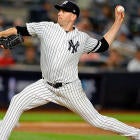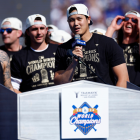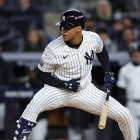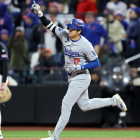On Sunday, the New York Yankees will face the Houston Astros in Game 2 of the American League Championship Series. The Yankees got a Game 1 win behind a strong performance from Gleyber Torres and an effective start from Masahiro Tanaka. Another win would put the Yankees in optimal position as the best-of-seven series shifts to New York.
For the Yankees to secure that win, they'll presumably need left-hander James Paxton to deliver his own quality start. How Paxton fares is of note for other reasons, too -- remember, back in April the Astros scorched Paxton for eight hits and five runs in four innings after discovering a tell in his delivery. "They knew what was coming, so they were fouling off some pretty good pitches, taking some pretty good pitches," Paxton told MLB.com.
If that sounds familiar, it's because the Astros advanced to the ALCS after doing something similar to Tampa Bay Rays starter Tyler Glasnow. The Astros are pretty good at picking up on these things, having also figured out a way in which then-Los Angeles Dodgers starter Yu Darvish was showing his hand during the 2017 World Series. Then-Boston Red Sox closer Craig Kimbrel also acknowledged he was tipping pitches following last year's ALCS victory over the Astros, though it's unknown if Houston picked up on that.
In fact, Paxton learned he was tipping from Carlos Beltran -- a former Astro who works for the Yankees.
Pitchers can tip in any number of ways. Fernando Rodney is an example of someone who used to show what was coming based on the height of his glove. John Axford's delivery gave away what was coming from him. And so on. Some pitchers even tip based on their facial expressions or other smaller tics that would be imperceptible to a viewing audience.
What was Paxton doing? Seemingly giving the runner at second base a look into his glove, thereby enabling them to deduce whether he was throwing his fastball or his curveball -- a pitch he delivers with a spiked grip, or with his pointer finger extended, making it easier to distinguish. There are a variety of ways for the runner to then convey that information to the hitter -- be it looking in one direction or another based on the pitch or location, placing their hands in a certain position, or whatever. Baserunners are sneaky monsters, basically.
Don't just take our word for it, either. Below, you'll see a pair of images from pitches Paxton made with a runner on second base during starts on the road against the Baltimore Orioles. The image on the left is from early in the season, before Paxton was notified he was tipping. The image on the right is from later in the season, when he'd made the necessary adjustments. Focus in on how his glove is angled directly toward second, so as to prevent the baserunner from detecting what he was going to throw ahead of time.
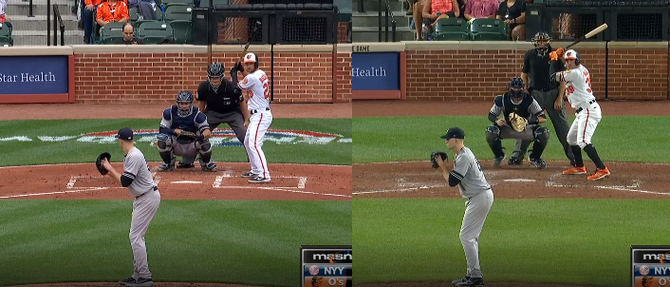
Notice the difference? See how Paxton's index finger gives away that he's throwing a curve on the left, and how that isn't the case on the right because the glove is tighter to his body and angled in a way that wouldn't enable a runner to pick up on the grip? It's a subtle tweak but apparently a difference maker.
Of course, it's possible the Astros will have figured out some other way to get Paxton's pitches ahead of time. That's part of the beauty of postseason baseball -- the game within the game. As such, pay careful attention to Paxton, to runners on second base and whether their glances seem to match up with certain pitch types, and to their swings (and takes) against curves.
For as paranoid as it sounds, if it seems like the Astros know what the pitcher is throwing ahead of time -- it's probably because they do.








